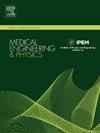An FE model investigating the bone-implant interface of Osseointegrated prosthetics to better understand how forces are transferred under loading
IF 1.7
4区 医学
Q3 ENGINEERING, BIOMEDICAL
引用次数: 0
Abstract
Background
Osseointegrated prostheses (OIP) use is increasing for above-knee amputees who have difficulties with sockets. This study aims to simulate the bone-implant interface under loading using a 3D finite element (FE) model and quantify force distribution to produce hypotheses on bone remodelling and implant failure, informing implant and surgical design, and rehabilitation protocols.
Methods
Ten customised 3D femur FE models (5 female, 5 male) were generated from CT scans and bone-implant assemblies created. The bone was subdivided into seven Gruen Zones and four proximal femur regions. Boundary conditions were taken from the literature.
Results
The highest stresses were found in the implant (Max: 113.9 MPa), whilst highest strains were seen in the bone (Max: 4.89 %). Stress and strain were unevenly distributed, with distal regions experiencing stress shielding effects and areas around the implant tip experiencing significantly higher stresses and strains (p < .001). Maximum stresses were higher in female bones (p < .01), whilst shorter residuum lengths saw significantly lower stresses (p < .05).
Conclusion
Sex, size and limb length are all important factors and these need to be accounted for when designing and implanting OIPs.
利用有限元模型研究骨整合假体的骨-种植体界面,以更好地理解载荷作用下的力传递
背景:对于有骨臼困难的膝以上截肢者,剂量集成假肢(OIP)的使用越来越多。本研究旨在利用三维有限元(FE)模型模拟载荷下的骨-种植体界面,并量化力分布,以产生骨重塑和种植体失败的假设,为种植体和手术设计以及康复方案提供信息。方法根据CT扫描生成10个定制的3D股骨FE模型(女性5个,男性5个),并制作骨植入物组件。骨被细分为七个格伦区和四个股骨近端区。边界条件取自文献。结果种植体的应力最大(Max: 113.9 MPa),骨的应力最大(Max: 4.89%)。应力和应变分布不均匀,远端区域存在应力屏蔽效应,种植体尖端周围区域的应力和应变明显较高(p <;措施)。女性骨骼的最大应力更高(p <;.01),而较短的残余长度显著降低应力(p <;. 05)。结论性别、大小和肢体长度是设计和植入人工髋关节时需要考虑的重要因素。
本文章由计算机程序翻译,如有差异,请以英文原文为准。
求助全文
约1分钟内获得全文
求助全文
来源期刊

Medical Engineering & Physics
工程技术-工程:生物医学
CiteScore
4.30
自引率
4.50%
发文量
172
审稿时长
3.0 months
期刊介绍:
Medical Engineering & Physics provides a forum for the publication of the latest developments in biomedical engineering, and reflects the essential multidisciplinary nature of the subject. The journal publishes in-depth critical reviews, scientific papers and technical notes. Our focus encompasses the application of the basic principles of physics and engineering to the development of medical devices and technology, with the ultimate aim of producing improvements in the quality of health care.Topics covered include biomechanics, biomaterials, mechanobiology, rehabilitation engineering, biomedical signal processing and medical device development. Medical Engineering & Physics aims to keep both engineers and clinicians abreast of the latest applications of technology to health care.
 求助内容:
求助内容: 应助结果提醒方式:
应助结果提醒方式:


